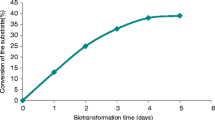Abstract
A novel bioinorganic catalyst was obtained via reduction of Pd(II) to Pd0 on to the surface of cells of Desulfovibrio desulfuricans at the expense of H2. Palladised biomass, supplied with formate or H2 as an electron donor, catalysed the dehalogenation of 2-chlorophenol and polychlorinated biphenyls. In the example of 2,3,4,5-tetrachlorobiphenyl, the bioinorganic catalyst promoted a rate of chloride release of 9.33 ± 0.17 nmol min−1 mg −1and only ~5% of this value was obtained using chemically reduced or commercially available Pd 0. In the case of 2,2′,4,4′,6,6′-hexachlorobiphenyl the rate was more than four orders of magnitude faster than the degradation reported using a sulfidogenic culture. Negligible chloride release occurred from any of the chloroaromatic compounds using biomass alone, or from palladised biomass challenged with hexane carrier solvent only. Analysis of the spent solution showed that in addition to catalysis of reductive dehalogenation the new material was able to remove very effectively the organic residua, with neither any PCB nor any breakdown products identifiable by GC/MS.
Similar content being viewed by others
References
P Adriaens PR Chang AL Barkovskii (1996) ArticleTitleDechlorination of PCDD/F by organic and inorganic electron transfer molecules in reduced environments Chemosphere 32 433–441 Occurrence Handle1:CAS:528:DyaK28XhsVCjtLk%3D
AC Aider MM Häggblom SR Oppenhelmer LY Young (1993) ArticleTitleReductive dechlorination of polychlorinated biphenyls in anaerobic sediments Environ. Sci. Technol. 27 530–538
S Ayris GM Currado D Smith S Harrad (1997) ArticleTitleGC/MS procedures for the determination of PCBs in environmental matrices Chemosphere 35 905–917 Occurrence Handle1:CAS:528:DyaK2sXlvFCgtL8%3D
F Bak FF Widdel (1986) ArticleTitleAnaerobic degradation of indolic compounds by sulfate-reducing enrichment cultures, and description of Desulfobacterium indolicium gen-nov., sp nov. Arch. Microbiol. 146 177–180 Occurrence Handle1:CAS:528:DyaL2sXivFymsA%3D%3D
I Fangmark B Bavel Particlevan B Marklund N Berge C Rappe (1993) ArticleTitleInfluence of combustion parameters on the formation of polychlorinated dibenzo-p-dioxins, dibenzofurans, benzenes, and biphenyls and polyaromatic hydrocarbons in a pilot incinerator Environ. Sci. Technol. 27 1602–1610
MM Häggblom LY Young (1995) ArticleTitleAnaerobic degradation of halogenated phenols by sulfate-reducing consortia Environ. Microbiol. 61 1546–1550
LCM Hartkamp-Commandeur J Gerritse AJ Govers JR Parsons (1996) ArticleTitleReductive dehalogenation of polychlorinated biphenyls by anaerobic microorganisms enriched from Dutch sediments Chemosphere 32 1275–1286 Occurrence Handle1:CAS:528:DyaK28XisVaqsbs%3D
GH Jeffrey J Bassett J Mendham RC Denny (1989) Vogel’s Textbook of Quantitative Chemical Analysis EditionNumber5 Bath Press Avon, UK
J Kazumi MM Häggblom LY Young (1995) ArticleTitleDiversity of anaerobic microbial processes in chlorobenzoate degradation-nitrate, iron, sulfate and carbonate as electron donors Appl. Microbiol. Biotechnol. 43 929–936 Occurrence Handle1:CAS:528:DyaK2MXpsFekt74%3D
N Korte L Lang R Muftikian C Grittini Q Fernando (1997) ArticleTitlePalladised iron utilised for ground water purification Plat. Met. Rev. 41 2–7 Occurrence Handle1:CAS:528:DyaK2sXitVeitrg%3D
A Li WJ Doucette AW Andren (1992) ArticleTitleSolubility of polychlorinated biphenyls in binary water-organic solvent systems Chemosphere 24 1347–1360 Occurrence Handle1:CAS:528:DyaK38XksFGns70%3D
JR Lloyd P Yong LE Macaskie (1988) ArticleTitleEnzymatic recovery of elemental palladium by using sulfate reducing bacteria Appl. Environ. Microbiol. 64 4607–4609
AN Mabbett (2001) The reduction and recovery of chromium(VI) from industrially polluted waste waters using sulphate-reducing bacteria The University of Birmingham UK
I Mikheenko (2004) Nanoscale palladium recovery The University of Birmingham UK
Mikheenko I, Mikheenko P, Darlington CNW, Muirhead CM, Macaskie LE (2001) Magnetic testing of Pd loaded bacteria. In: Ciminelli VST, Garcia O, eds. Biohydrometallurgy: Fundamentals, Technology and Sustainable Development. Elsevier, pp. 525–532.
TN Rhodin G Ertl (1979) In The Nature of the Surface Chemical Bond North Holland Publishing Co., The Netherlands 102–107
GD Sayles G You M Wang MJ Kupferle (1997) ArticleTitleDDT, DDD and DDE dechlorination by zero-valent iron Environ. Sci. Technol. 31 3448–3454 Occurrence Handle1:CAS:528:DyaK2sXmvValtLs%3D
JM Tiedje JF Quensen J Chee-Sanford SA Schmichel SA Boyd (1993) ArticleTitleMicrobial reductive dechlorination of PCBs Biodegradation 4 231–240 Occurrence Handle1:CAS:528:DyaK2cXkvFSksbc%3D Occurrence Handle7764920
J Weigel Q Wu (2000) ArticleTitleMicrobial reductive dehalogenation of polychlorinated biphenyls FEMS Microbol. Ecol. 32 1–15
MA Wright CJ Knowles J Stratford SA Jackman CK Robinson (1996) ArticleTitleThe dechlorination and degradation of Araclor 1242 Int. Biodeterior. Biodegr. 38 61–67 Occurrence Handle1:CAS:528:DyaK2sXjtFKiug%3D%3D
P Yong JPG Farr IR Harris LE Macaskie (2002a) ArticleTitlePalladium recovery by immobilized cells of Desulfovibrio desulfuricans using hydrogen as the electron donor in a novel electrobioreactor Biotechnol. Lett. 24 205–212 Occurrence Handle1:CAS:528:DC%2BD38XhsVShtrg%3D
P Yong NA Rowson JPG Farr IR Harris LE Macaskie (2002b) ArticleTitleBioreduction and biocrystallization of palladium by Desulfovibrio desulfuricans NCIMB 8307 Biotechnol. Bioeng. 80 369–379 Occurrence Handle1:CAS:528:DC%2BD38XotFSjsLg%3D
P Yong JPG Farr IR Harris NA Rowson LE Macaskie (2003) ArticleTitleA novel electrobiotechnology for the recovery of precious metals from spent automotive catalysts Environ. Technol. 24 289–297 Occurrence Handle10.1080/09593330309385561 Occurrence Handle1:CAS:528:DC%2BD3sXivFWnt7Y%3D
Author information
Authors and Affiliations
Corresponding author
Additional information
Revisions requested 8 September 2004; Revisions received 21 October 2004;
Rights and permissions
About this article
Cite this article
Baxter-Plant, V., Mikheenko, I., Robson, M. et al. Dehalogenation of chlorinated aromatic compounds using a hybrid bioinorganic catalyst on cells of Desulfovibrio desulfuricans . Biotechnol Lett 26, 1885–1890 (2004). https://doi.org/10.1007/s10529-004-6039-x
Received:
Accepted:
Issue Date:
DOI: https://doi.org/10.1007/s10529-004-6039-x




